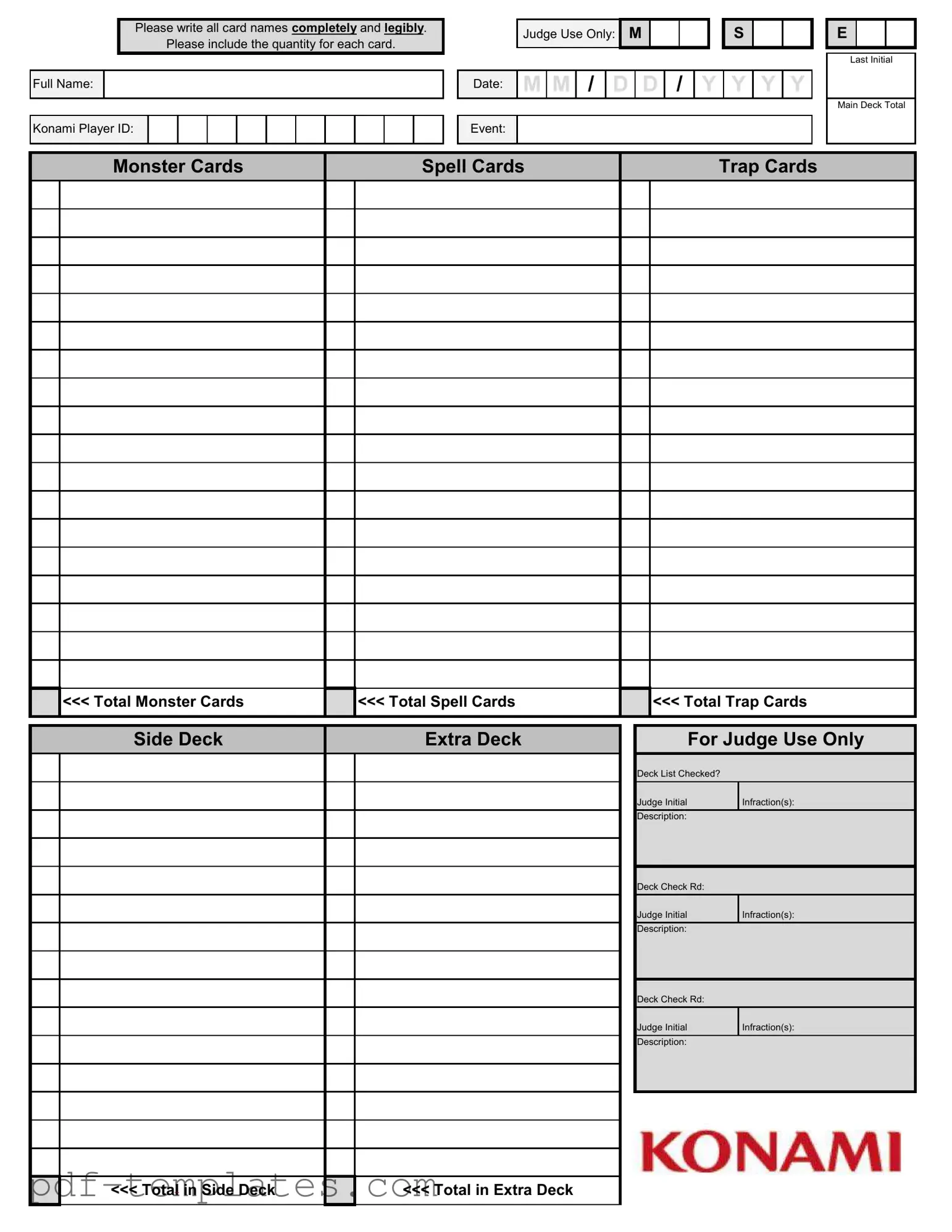The Konami Decklist form shares similarities with the Magic: The Gathering Decklist form. Both documents require players to list their card names clearly and accurately, ensuring that all details are easily readable. Each form asks for the quantity of each card, which helps judges verify that players are following the rules regarding deck composition. Additionally, both forms include sections for player identification and event details, making it easy to track who is participating in a specific tournament.
Another document that resembles the Konami Decklist is the Pokémon Trading Card Game Decklist form. Like the Konami form, it requires players to write down their card names and quantities. This standardization allows judges to quickly assess a player's deck for compliance with tournament regulations. The Pokémon form also includes sections for player information and event specifics, ensuring that all relevant details are collected in one place.
The Yu-Gi-Oh! Tournament Registration form is another similar document. It captures essential player information, such as full name and player ID, just like the Konami Decklist. While the focus of the registration form is on the participant rather than the deck, it still serves to streamline the tournament process. Having both forms completed ensures that judges have a comprehensive view of each player's involvement.
The Standardized Player Registration form used in various tabletop gaming tournaments shares characteristics with the Konami Decklist. This form also collects player details and event information. While it does not focus on deck composition, it is essential for maintaining an organized tournament. Both forms help create a structured environment for competitive play, making it easier for judges to manage participants.
The Event Match Report form, often used in organized play, is another document that bears resemblance to the Konami Decklist. It records match results and player performance, similar to how the decklist tracks card usage. Both documents serve to maintain the integrity of the tournament by documenting important information. Judges rely on these forms to ensure fair play and adherence to the rules.
Understanding the importance of having a comprehensive form for delegating healthcare decisions, similar to other forms in the gaming world, is crucial. For instance, just as players meticulously prepare their decklists to ensure clarity and compliance, individuals should also consider using the All California Forms to set up a Medical Power of Attorney form. This ensures that their healthcare preferences are respected and clearly communicated, aligning with the need for organized and trustworthy documentation across different contexts.
The Player Score Sheet used in competitive events is also similar. It tracks player performance throughout a tournament, much like how the Konami Decklist tracks card usage. Both documents help judges monitor player compliance and performance, ensuring that the tournament runs smoothly. The organization of information in both forms aids in quick reference during events.
The Match Slip, used in many card games, has parallels to the Konami Decklist as well. It records the outcome of individual matches and player details. While the focus is different, both documents are essential for maintaining a clear record of the tournament. They help judges keep track of player standings and ensure that all matches are accounted for.
The Player Information Sheet is another document that shares similarities with the Konami Decklist. It collects details about the player, such as name and contact information, much like the identification section of the decklist. Both forms are crucial for tournament organization, allowing judges to easily access player data when needed.
Lastly, the Tournament Feedback Form can be compared to the Konami Decklist. While its purpose is different, both documents contribute to the overall tournament experience. The feedback form gathers player insights on the event, while the decklist ensures compliance with game rules. Together, they help improve future tournaments and enhance player satisfaction.
